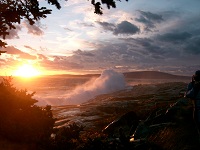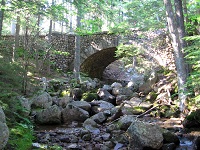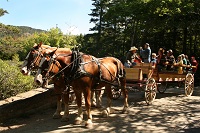
Well before John D. Rockefeller, Jr. became involved with conservation in the Yellowstone region, he demonstrated his interest in land preservation elsewhere in the country. One of his earliest conservation projects involved setting aside land and designing a road system for Acadia Naitonal Park, orginally called Mount Desert Island.
"For nearly five centuries, beginning with the mariners of the 1500's, the hills of Acadia have been a familiar sight to Atlantic voyagers. To thousands of people its diversified scenery has been one of the great natural beauties of the world. By the 1870's, as the names of Island communities - Bar Harbor, Northeast Harbor, Seal Harbor - became world famous, the Island began to attract visitors in such volume that its natural beauties were threatened with destruction by hastily improvised accommodations. In 1901 President Charles W. Eliot of Harvard, and George B. Dorr, summer residents, began to solicit gifts of land and money from other residents to save the Island. These lands, given to the United States in 1916, eventually became the first National Park to be composed entirely of gifts from individuals. Mr. Rockefeller, Jr., donated 2,700 acres to round out the Park from Frenchman Bay on the north to the Atlantic on the south..."

"In 1917 he conceived an idea to make the area more than a preserve; he originated plans sent to the Secretary of the Interior, offering to build and maintain a road system to open up the lovely vistas of Acadia to visitors. Pursuing an old enthusiasm, he spent hours with surveyors and engineers in designing and constructing some sixty miles of roadways and bridges. In general, the purpose of his gifts to Acadia through the years was to make more accessible to visitors what he regarded 'as one of the greatest views in the world.'" - The Heritage of Every American, pg. 49
Rockefeller participated in the construction process. He walked areas staked out for road alignment and observed work in progress. He knew the laborers by name and used experts to design the bridges and engineer the roads. Throughout it all, he paid great attention to the most minute details, from the placement of coping stones to the cost of a running foot of road.
The result of Rockefeller's vision and attention to detail is an integrated system of carriage roads that blends harmoniously with the landscape.

For more information on Rockefeller's role in constructing the historic carriage roads, visit Acadia National Park's Historic Carriage Roads page .
